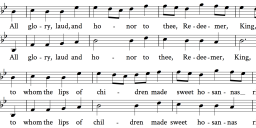All Glory Laud / St Theodulph descant
-
Anyone know where I can find a free online organ descant or alternative accompaniment of this hymn in Bb?
Thanks -
"Organ descant" is a misnomer which I hear or read all too often, but I think you mean an alternate harmonization or accompaniment that is more florid or elaborate than the hymnal harmonization.
The term "descant" specifically (in the context of hymns as well as other compositions) refers to a countermelody to the main melody, usually (although not always) pitched higher than the main melody.
-
You might use the Bach harmonization (from the St. John Passion). Here it is, transposed, with my own (treble) descant.

 St Theodulph-with descant.pdf20K
St Theodulph-with descant.pdf20K
 St Theodulph-with-descant.mp31001K
St Theodulph-with-descant.mp31001K -
I took this from Gerre Hancock's accompaniment, heard here; he played it slightly differently each time, but this is the line, with a few things smoothed over to make it more singable. https://soundcloud.com/inmemoriamgerrehancock/all-glory-laud-and-honor-st-theodulph-and-lift-up-your-heads-ye-mighty-gates-truro

 All Glory, Laud and Honor descant hancock.png2275 x 872 - 120K
All Glory, Laud and Honor descant hancock.png2275 x 872 - 120K -
The descant notes on "All glo-ry, laud, and ho-nor to thee, Re-" are just the alto part transposed up an octave in a standard harmonization. After that, the part skips up to an elaboration of the tenor part, up two octaves. This is a pretty standard way of forging (fakebooking?) a descant from inner voices. Hancock's choir does not sing a descant on the verses.
-
Yes, I just put this together to avoid explaining to the choir how to do that and how to mark it in their scores...the hymn has already caused me enough grief due to the need to Xerox parts from one hymnal and edit the text edits in there to agree with the pew hymnals, whose choral book lacks several verses &c.
-
It is nice when the tenor part is interesting enough to sing as a descant. =)Thanked by 1canadash
-
Transposing inner parts into a descant may be a common practice where a composed one is not available, but I have always shunned doing this because of the all-to-transparent irritance of doubled voices and objectionable parallel octaves and such. It is easy enough to compose one's own if one isn't at hand. The difficulty here is in composing one that is not overly elaborate! I always end up with something really challenging - like those of Willcocks or Ledger. Choirs love the result, though. There are many published booklets of descants for a variety of hymn tunes available from Oxford and others.
-
[Jackson just modestly put himself in the same category as Sir David Wilcocks and Phillip Ledger. That's exalted company, especially if true.]
-
Descant-wise, perhaps.
Otherwise - not holding a candle to. -
I definitely prefer descants that act as rhythmic counterpoint: ties over measure bars, discreet syncopation and what have you. Because most strophic harmonizations that are commonly used lack that*, I find doubling an inner voice to be weak tea, in addition to the reasons MJO cites. (Doubling of voices is, however, canonical practice for American shape-note hymnody.)
* Unless you're using, say, one of JS Bach's more interesting chorale harmonizations... A particularly choice descant can be found at the 2:21 mark here (used by a trumpet, but illustrative of a more spectacular descant genre):
https://www.youtube.com/watch?v=mnDm5Ok2xOY
-
I didn't actually mean doubling another's part, octaves above. I meant singing that part as a descant, while the voice from which it was taken sings either the melody or another voice part.Thanked by 1MarkS
-
I'll have to try that with the tenor part from "Angels we have heard on high" sometime.
Welcome to the MusicaSacra Forum!
To participate in the discussions on Catholic church music, sign in or register as a forum member, The forum is a project of the Church Music Association of America.
Categories
- All Discussions21,108
- General Music Discussion8,218
- Job Openings197
- Management of Music Programs850
- Choral Matters533
- Church Documents and Rubrics524
- CMAA Notes302
- Events716
- For Newcomers: Read First26
- Sacred Polyphony546
- Hymnody872
- Gregorian Chant: General2,698
- ↳ Graduale Romanum and Liber Usualis368
- ↳ Graduale Simplex60
- ↳ Semiology63
- Vernacular Plainsong696
- Anglican Use and Anglican Chant68
- Organ, Other Instruments and Repertoire435
- New Composition/Works in Progress1,291
- Recordings231
- Music for Hispanic Ministry159
- Music Education: Children211
- Music Education: General222
- News Items245
- Positions Wanted2
- General Discussion: Catholicism739
- Amusements177
- General Discussion1,033
- Opinions117



